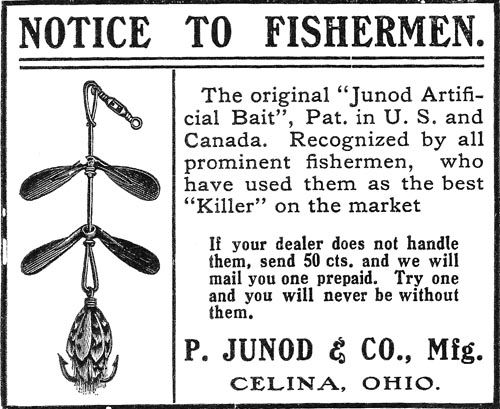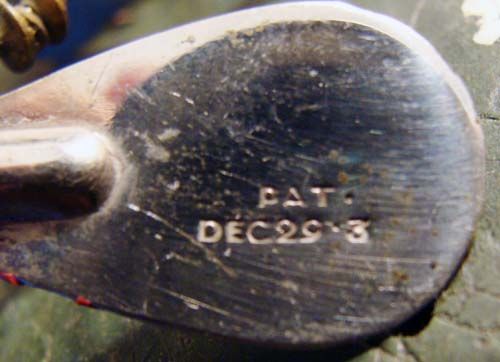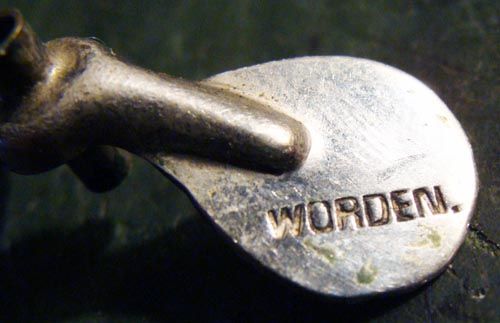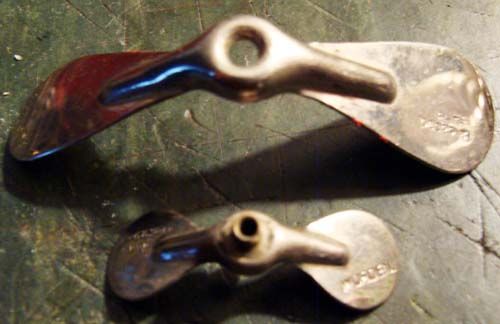What's in a Patent? Paul Junod
How often do we see a Heddon Lure which is obviously from the teens or the twenties offered for sale in “1902 Box”? Turns out the only thing about the box that is 1902 is the date of Jim Heddon's first lure patent for cup and screw hook hardware. Folks in the fishing tackle industry (I'm sure there are others as well) just seem to love plastering patent numbers and dates all over their boxes, reels and even lure diving lips. Many of these patents are ones that the company holds but have nothing to do with the object at hand. They generally seem to be there to discourage imitation. In the case of lures it does not appear to discourage many of the "copycat" attempts to cash in on a successful product.
What brings all this to mind is repeated listings of Worden wooden minnows as “1903 baits” due to the patent date “Dec 29 1903” stamped on one end of the spinner and the name “Worden” stamped on the opposite blade. It has been demonstrated over and over that Mr Worden did not offer wooden minnows to the public until 1905. So where does that 1903 date come from. That is the subject of today's ad from the July 1905 issue of National Sportsman.

Paul Junod was a Jeweler in Celina Ohio at the turn of the last century. We must assume that Paul was a fisherman as he manufactured fishing tackle for a good many years. His first spinner patent was granted November 1st 1898 and was for a propeller-shaped spinner that turned freely on a fixed shaft. The spinner was reinforced with a metal strip soldered to the underside which gave the spinner a stiffer constitution. His second patent was granted on 29 Dec 1903 and was also for a reinforced spinner, but this time strength was achieved by stamping a raised rib along the long axis of the blade. It acts in the same way as a piece of angle iron, which of course is much harder to bend than the same piece of flat steel. Chances are that this form was far easier and cheaper to manufacture than the earlier design. It was a huge success. Not only did Mr. Junod produce his own spinner as seen in this 1905 ad, but he licensed its use to other companies such as Worden and Shakespeare. They did however have to stamp the patent date on the spinner blade. Hence we see the 1903 date on products that Worden and Shakespeare didn't produce until well after 1903.
For many years when I saw this style of tandem spinner I wondered how it was fished as it is too light for casting, especially on cc1900 equipment. We are left with two alternatives. Trolling behind a rowboat or a popular form of bass fishing in those early days that is somewhat forgotten now. Where I grew up in Ohio is was called “Flipjacking” and usually consisted on one man rowing and another standing with a very long cane pole. Unlike “Skittering," which was done with a short line on a long pole, Flipjacking used a line the same length as the cane pole--usually 16 or 18 feet. The Spinner was swung out and pumped up and down next to stumps and openings in lily pads. It was a deadly method that was still practiced by a few in my youth. Large bass were unceremoniously lifted clear of the water and swung into the boat. And we think “flipping” as practiced today is something new!
The following pictures show an original Junod Spinner., Close ups of the stamping on each end of the Junod Blade and one comparing an original Junod blade to one that Mr Worden used in South Bend.





-- Bill Sonnett
Heya Dr. Todd,
ReplyDeleteI am pleased to have stumbled across your blog.
I like what you are doing here very much and will be dropping in.
Dr. Mike
Thank you so much for sharing, I appreciate your post. I recently discovered that Paul Bernard Junod Sr. was my great-great-great grandfather.
ReplyDelete